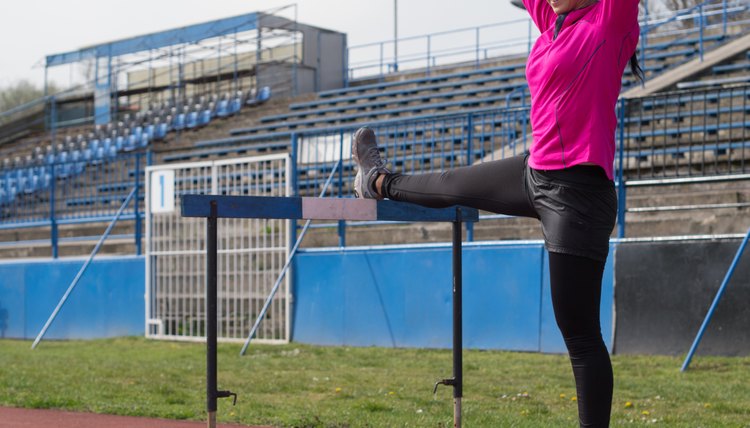How to Run a Faster 300-Meter Hurdle

Track and field consists of competitions that include running, hurdles, jumping and throwing. A common running and hurdle event in high school is the 300-meter hurdles. Competitors are required to run 300 meters while jumping over a series of eight hurdles. Running a fast 300-meter hurdle event requires a combination of speed, power, endurance, strength, running technique and hurdling technique. To improve your time in the 300-meter hurdle, you must follow a training approach that focuses on every element of the race.
Experiment with different body positions in the starting blocks and practice exploding out of the blocks. Keep your toes and balls of the feet on the track with the heels on the starting blocks. Use a stopwatch to time the first 20 meters.
Practice hurdling technique. Some runners rely on speed and power to jump over the hurdles but proper technique can shave seconds off your race time because it requires less time and energy to jump over the hurdles. Maintain a natural stride length and frequency as you approach the hurdles. Avoid taking short, choppy steps. As you approach the hurdle, jump directly at the hurdle with one foot forward when you are about 6 to 7 feet away. Keep the front leg bent slightly and bring the trailing leg over the hurdle horizontally.
Improve sprinting technique to increase speed between the hurdles. Three fundamentals of proper running form is standing tall, and keeping your knees and toes up. Standing tall and maintaining body posture keeps your center of mass directly above the hips and allows the lead foot to land directly under the hips. Move the feet in a circular direction. When the foot leaves the ground behind you, bring it forward past the opposite knee and directly to the ground. Keep the foot in dorsiflexion--pulling the toes up toward the shin--throughout the running stride.
Build muscular endurance--defined as the ability to perform repetitions over a period of time--through strength training. Perform a combination of power exercises to improve lactate threshold and maximal strength training exercises that improve maximal strength and the potential for strength endurance. Choose functional strength training that train multiple muscle groups at the same time such as squats, deadlifts, lunges, cleans, presses, push-ups, pull-ups and sit-ups.
Tips
The objective of hurdling technique is to minimize the vertical deviation of the center-of-gravity. Have a coach give you instant feedback on your form and technique.
References
Writer Bio
Based in Nebraska, Jeremy Hoefs began writing fitness, nutrition, outdoor and hunting articles in 2006. His articles have been published in "Star City Sports," "Hunting Fitness Magazine" and RutWear field journals, as well as on the Western Whitetail website. Hoefs graduated with a Bachelor of Science in exercise science from Nebraska Wesleyan University.
